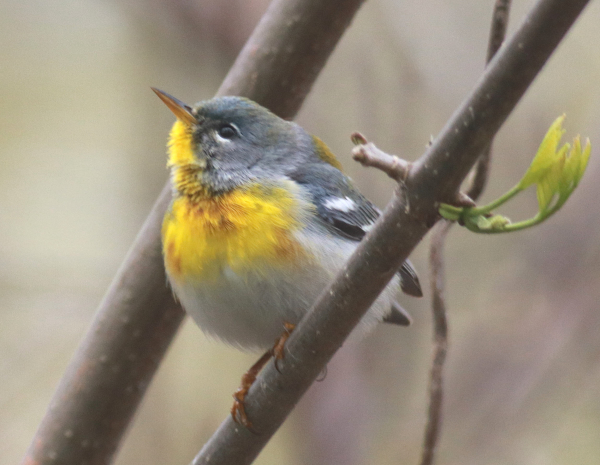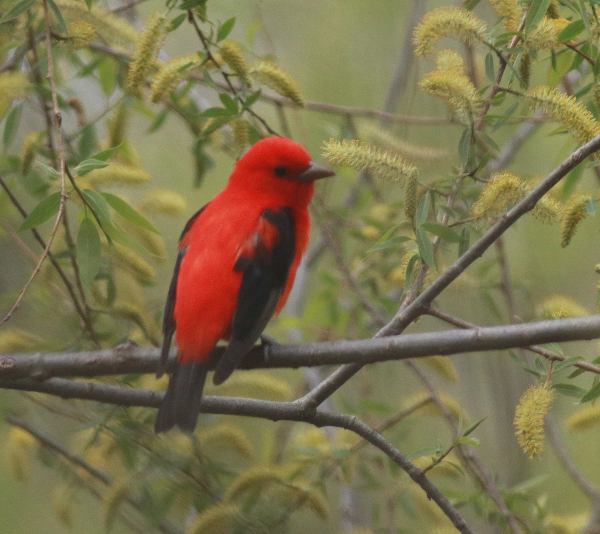
A Cape May Warbler shows honeysuckle pollen on its bill during a momentary break in its foraging regimen.

Paul’s first photo of a Northern Parula, a warbler he has rarely seen before last week.

A brilliant red male Scarlet Tanager perched in a flowering willow tree provided a tranquil scenic portrait.
|
How good a birding site is the Magee Marsh boardwalk area during The Biggest Week in American Birding? Within a half hour of arriving Friday evening, I added two life birds – both warblers – a male Canada Warbler and a young male Hooded Warbler! I expected the Canada; in fact I hope for lots of Canada Warblers as I timed my visit to coincide with their arrival. But even wishing to see a Hooded Warbler would be a stretch I figured, considering northwest Ohio is north of their nesting range. Yet, within the last hour of the day Friday, there he was! And both these lifer warblers were within 15 feet of one another at eye level! Then and there, I figured the boardwalk should be renamed “the magic carpet.”
Little could I imagine, even then, how magic that boardwalk would really become. The next morning would be the real test. I timed my visit to arrive for the Saturday sunshine about 90 minutes after sunrise, the sky was beautiful blue. There was a considerable assemblage of vehicles and birders on site already, with hundreds more to follow, and I was thrilled to be among many people with like interests and to enjoy a fun and fulfilling day among my favorite people in the world – birders.
An hour before I actually returned to the boardwalk, I was short-stopped by the presence of a group of photographers on the edge of the wooded boardwalk area where the morning sun illuminated vivid green-leaved trees and some small songbirds were clearly active in front of the aimed telephoto lenses. That was a fun hour among seasoned bird photographers who were as excited as I was to attempt to photograph a number of different warblers – a Chestnut-sided, Cape May, Black-throated Blue, and a couple Bay-breasted Warblers – plus a pair of robins, a number of Baltimore Orioles, and a brilliant red and black Scarlet Tanager. What fun!
When I did go to the boardwalk, it was packed with excited birders – in contrast to the evening before when a few birders plied the wooden walkway. I describe much about the group of birders in this issue’s Birding Lifestyles feature, along with my Bird Photography article; so I will emphasize the birds I enjoyed seeing and photographing here. I’ll just say that the boardwalk experience Saturday was unlike any other birding activity I’ve ever been part of, among a movement of hundreds of birders, with a constant movement of warblers – mostly at eye level, and some very close.
I was thrilled by many Northern Parulas, Chestnut-sided, Black-throated Greens, Cape Mays, and Bay-breasted Warblers, along with a few Black-throated Blues and Blackburnians, and a glowing Prothonotary – all birds I very rarely or never get to see on the west end of the eastern warbler migration flyway. There were also warblers I do see in my neighborhood on select May days, namely Magnolias, Yellows, Tennessees, Palms, Nashvilles, Black-and-Whites, Yellow-rumps, Blackpolls, Common Yellowthroats, and American Redstarts – that’s 18 species, plus the 2 lifers I spied Friday evening = 20! It’s been far too long since I’ve spent time at an eastern warbler hotspot during the peak of spring migration, so it was very fun, exciting, fulfilling, and enriching to spend hours in the midst of these remarkable warblers!
Other standout songbirds included Scarlet Tanagers, Baltimore Orioles, Northern Cardinals, Red-eyed Vireos, Warbling Vireos, Blue-gray Gnatcatchers, Gray Catbirds, Brown Thrashers and, of course, American Robins. Larger birds included nesting Bald Eagles, Sandhill Cranes, Trumpeter Swans, Red-tailed Hawks, a Broad-winged Hawk, and I was especially surprised to see an American Woodcock crouched on the edge a wooded wetland.
It’s been a while since I took a road trip, and I questioned the idea of leaving home when a few flights of warblers, orioles, vireos, thrushes, grosbeaks, and flycatchers would pass through my Dakota homeland, but I stocked my hummingbird feeder and oriole feeder and filled my bird bath, while placing 10 orange halves at my feeding station to try to keep the first neotropical migrants interested in staying around my yard. Now that I’m on the southwest shore of Lake Erie, I’m glad to be here, photographing birds that don’t pass through my area of the Great Plains.
Tomorrow should be another exciting day photographing among Chestnut-sided, Black-throated Blues, Northern Parulas, Cape Mays, Bay-breasted Warblers, BBlack-throated Greens, Prothonotary, and Canada Warblers, along with many other impressive birds. I’ll fill you in next week – enjoy the migration.
Article and photos by Paul Konrad
Share your bird sightings and photos at editorstbw2@gmail.com